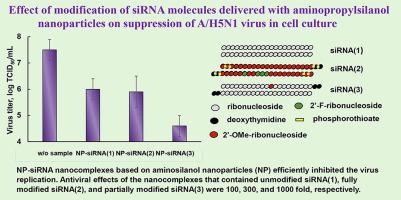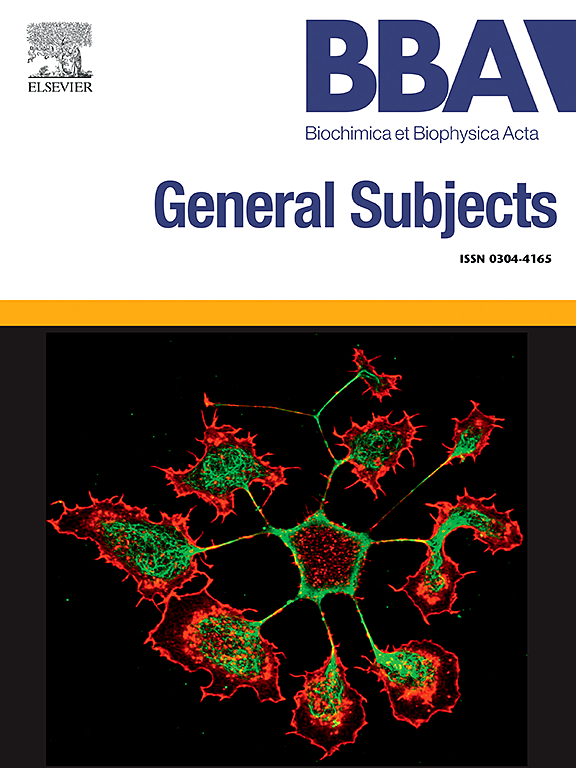Effect of modification of siRNA molecules delivered with aminopropylsilanol nanoparticles on suppression of A/H5N1 virus in cell culture
IF 2.8
3区 生物学
Q3 BIOCHEMISTRY & MOLECULAR BIOLOGY
Biochimica et biophysica acta. General subjects
Pub Date : 2024-10-20
DOI:10.1016/j.bbagen.2024.130727
引用次数: 0
Abstract
The application of siRNAs as antiviral agents is limited by several obstacles including their poor penetration into cells and instability in biological media. To overcome these problems, we used non-agglomerated aminopropylsilanol nanoparticles (NP) to deliver siRNA into cells. All studied siRNAs had identical nucleoside sequences comprising phosphodiester or phosphorothioate (PS) internucleotide groups and the 2’-OMe and/or 2’-F groups in nucleoside units at different positions of RNA. The siRNA molecules were attached to NP, thus forming the NP-siRNA nanocomplexes. We studied the effect of siRNA modification in the nanocomplexes on suppressing the highly pathogenic influenza A/H5N1 virus replication. The results demonstrated that all siRNA-containing nanocomplexes inhibited the replication of the A/H5N1 virus by 1–3 orders of magnitude. The nanocomplexes containing partially modified siRNAs exhibited the most pronounced inhibition with an efficacy of 900-fold. This result was achieved by using siRNA consisting of the canonical 19-bp RNA duplex with the 3′-dTdT dangling ends, with the antisense strand in this duplex being protected from endonucleases (one UMeA site within the strand). The additional modifications of siRNA reduce their antiviral activity. Promising sense strands for loading into the RISC complex are likely to be phosphodiester sequences that contain dTdT at the 3′ end (such as S4) to be protected against exonucleases. The sense strands of this type can probably be the most suitable for designing siRNAs as therapeutic agents. The proposed NP-siRNA nanocomplexes that consisted of low toxic and non-agglomerated aminopropylsilanol nanoparticles and siRNA molecules could be hopeful agents for gene silencing.

用氨基丙基硅烷醇纳米颗粒递送的 siRNA 分子的修饰对抑制细胞培养中的 A/H5N1 病毒的影响。
siRNAs 作为抗病毒药物的应用受到几个障碍的限制,包括其对细胞的穿透性差和在生物介质中的不稳定性。为了克服这些问题,我们使用了非凝集的氨基丙基硅烷醇纳米颗粒(NP)将 siRNA 送入细胞。所有研究的 siRNA 都具有相同的核苷序列,包括磷酸二酯或硫代磷酸酯(PS)核苷酸间基团,以及位于 RNA 不同位置的核苷单位中的 2'-OMe 和/或 2'-F 基团。siRNA 分子附着在 NP 上,从而形成 NP-siRNA 纳米复合物。我们研究了纳米复合物中的 siRNA 修饰对抑制高致病性甲型 H5N1 流感病毒复制的影响。结果表明,所有含有 siRNA 的纳米复合物对 A/H5N1 病毒的复制都有 1-3 个数量级的抑制作用。其中,含有部分修饰 siRNA 的纳米复合物的抑制效果最明显,达到了 900 倍。这一结果是通过使用由带有 3'-dTdT 悬挂末端的 19-bp RNA 双链组成的 siRNA 实现的,该双链中的反义链受到内切酶的保护(链中有一个 UMeA 位点)。siRNA 的额外修饰会降低其抗病毒活性。有望装入 RISC 复合物的有义链可能是在 3' 端含有 dTdT 的磷酸二酯序列(如 S4),以防止外切酶。这种类型的有义链可能最适合设计成 siRNA 作为治疗药物。拟议的 NP-siRNA 纳米复合物由低毒、无凝集的氨基丙基硅醇纳米颗粒和 siRNA 分子组成,有望成为基因沉默的药物。
本文章由计算机程序翻译,如有差异,请以英文原文为准。
求助全文
约1分钟内获得全文
求助全文
来源期刊

Biochimica et biophysica acta. General subjects
生物-生化与分子生物学
CiteScore
6.40
自引率
0.00%
发文量
139
审稿时长
30 days
期刊介绍:
BBA General Subjects accepts for submission either original, hypothesis-driven studies or reviews covering subjects in biochemistry and biophysics that are considered to have general interest for a wide audience. Manuscripts with interdisciplinary approaches are especially encouraged.
 求助内容:
求助内容: 应助结果提醒方式:
应助结果提醒方式:


